Tudor and its Heritage – The 1970s Chronographs and the Tudor Heritage Chrono
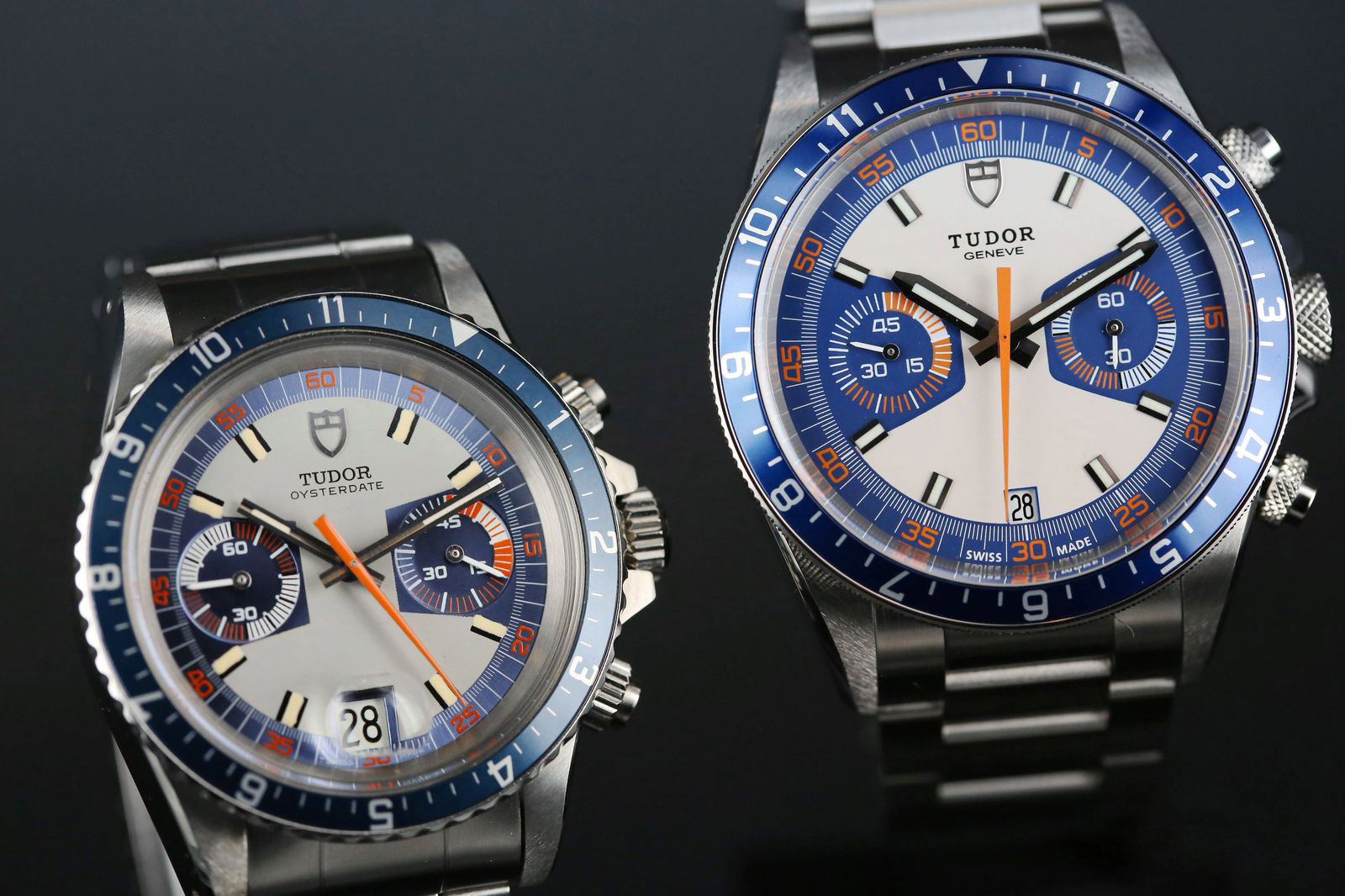
As we’ve seen in our two first episodes of “Tudor and its Heritage“, the brand made an important move into sports watches in the middle of the 1950s, starting with the Submariners, followed by the Ranger. These vintage pieces formed the basis for the creation of two current watches, the Heritage Black Bay and the Heritage Ranger, which pay tribute to the rich past of Tudor Watches. However, there’s another type of watch that we haven’t explored yet, and in this field, Tudor has been very active: chronographs. Today, we are going to look at how, starting in 1970, the brand created some highly iconic and bold chronographs, which later inspired the super-cool Tudor Heritage Chrono.
The modern definition of a vintage-inspired Chronograph by Tudor, the 70330N Heritage Chrono
Surprisingly, while many other sports-oriented brands and sister-company Rolex were all playing hard in the field of sports or racing chronographs since at least one decade (an even more if we consider the introduction of a certain Speedmaster in 1957), Tudor came much later in the race. Sports-watches were already much deployed over the collection, with the Submariners playing the superstar role, later followed in the 1960s by the Ranger (an exploration watch). However, the first chronographs by Tudor only appeared in 1970. As children of the “Seventies”, these early chronographs were designed accordingly to the slightly psychedelic feel that was going on at that time: bold shapes, massive cases, graphic lines and bright colors were the key inspirations. Two generations represent these early days of Tudor chronographs, the 70xx series and the 71xx series, both great sources of inspiration for the watch that is now known as the Tudor Heritage Chrono.
1970, the birth of Tudor’s Chronographs, the Oysterdate 70xx Series
The Key characteristics of these early chronographs, and the features that certainly talk most to collectors, remain definitely the pentagonal hour markers, the bright colours and the trapezoidal sub-dials. The 70xx series of chronograph by Tudor simply laid the foundations for will later become an awarded and praised collection of sporty chronographs. Tudor has earned a place apart in the field of sports chronographs, embodied in the development of four successive families of products. In 1970, with the launch of its first mechanical manually-wound model, the Oysterdate Chronograph, the brand immediately impressed aficionados through its bold design, a distinct identity and the usual superb quality of the watches.
The first Series of Chronographs by Tudor was the 70xx and comprised three different references – two were production pieces and one was a prototype, which doesn’t remove anything to its historical importance. The pieces were named OysterDate, and not Oyster Prince, as featuring a manually wound movement, the Valjoux 7734 Calibre, with cam mechanism chronograph. Based on a same case – a 39mm bold Oyster case, water resistant to 50m – with a highly masculine design – robust central container, large external and graduated bezel, screwed pushers – the three variations differentiated by their types of bezel. Two were produced in large numbers (7031 and 7032), while the third was never commercialized and remained at the prototype stage (7033).
- The two first references, the Tudor Oysterdate Chronograph 7031/0 and 7032/0
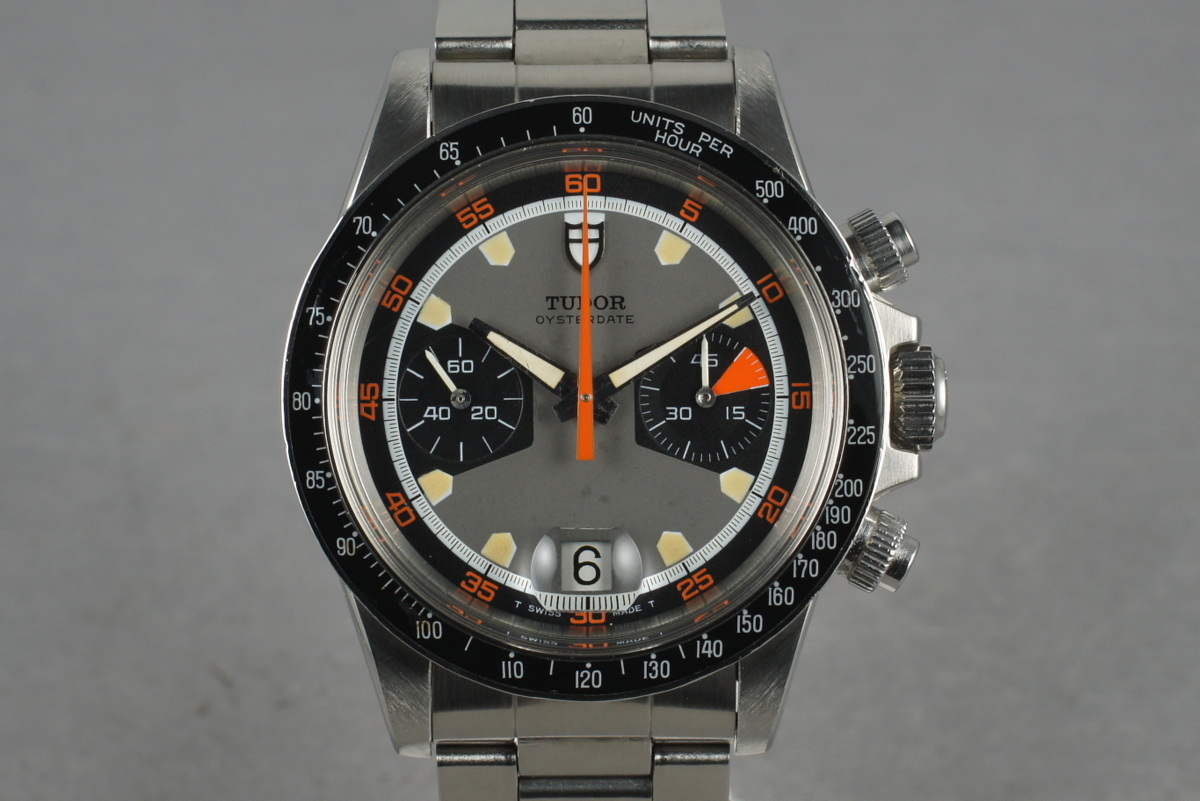 The Oysterdate 7031/0 (photo credits – HQ Milton)
The Oysterdate 7031/0 (photo credits – HQ Milton)
With these two watches, we already have all the key elements that will later create the iconic collection. The Tudor Oysterdate 7031/0 and 7032/0 have been introduced in 1970, as the first chronographs of the brand. Both watches are extremely close and share all their parts, to the exception of the bezel. It was based on 39 mm case, waterproof to a depth of 50 metres and housed a manually-wound mechanical, the famous and widely-used Valjoux 7734 movement. The case back was engraved “Original Oyster Case by Rolex Geneva”. Its steel bracelet was a Rolex Oyster-type bracelet, reference 7836, with folding links. Located at 3 and 9, thus being a so-called bi-compax, the two counters of this grey and black dial with distinctive hour markers indicated, respectively, the seconds of the permanent display and the elapsed minutes of the chronograph function.
The other 1970 option, the Oysterdate 7032/0 (photo credits – HQ Milton)
The dial is certainly what stands out most on these watches: a grey central area, black sub-dials and minute track (on the periphery), a white second track, the iconic trapezoidal sub-dials and finally, the unconventional luminous pentagon-shaped painted hour markers that earned them the nickname “home plate” in collectors’ circles because they were reminiscent of the shape of the home plate on a baseball field. The hands were large and filled with tritium, for a maximized legibility, confirming the sports vocation of these watches. Because of the movement used, the minute-counter was recording 45-minute intervals. The date was displayed at 6 with a cyclops integrated in the Plexiglas crystal.
Thanks to the Oyster case and to the screwed pushers and crowns, the Tudor Oysterdate Chronograph 7031/0 and 7032/0 were waterproof to 50m. The screwed pushers also prevented any accidental engagement of the chronograph – something that was first introduced on the big-sister Daytona. These watches were large – 39mm – and had a strong design, especially when looking at the square crown guards and the overall bulky shape of the lugs. No doubt to have on their vocations.
The main and only difference between the Tudor Oysterdate Chronograph 7031/0 and the 7032/0 was the bezel. In both cases, it was fixed and displayed a tachymeter scale, used to calculate an average speed between two points. Both had a 500-unit graduated scale and both used the same graduation. However, the 7031/0 had a bezel topped with a Plexiglas insert while the 7032/0 had a satin-finished steel bezel, with engraved the scale. This duality of the bezel is something that the Rolex group used on the Daytona – depending on the reference, you could opt for a black insert or satin steel.
- The experimental one, the Tudor Oysterdate Chronograph 7033/0
While being in all points (to one exception) equal to the 7031/0 and the 7032/0 – same 39mm case, same dial, same markers, indexes, sub-dials or colours – this watch introduced a featured that will be used later, both in vintage watches (in the ref. 7169) and in the current Tudor Heritage Chrono: the bidirectional rotatable bezel with a 12-unit graduated black anodised aluminium insert. While the two other references are more suitable for a racing use, this one played more on the pilot trend – and could also be used to track a second time-zone. Unlike the two preceding models it was never commercialized, however its historical importance can’t be denied.
1971, the evolution of Tudor’s Chronographs, the Oysterdate “Montecarlo” 71xx Series
Shortly after the introduction of the first chronographs, the 70xx series, Tudor Watches slightly updated the models. Technically, the brand adopted new movements. Visually, we had slight evolutions of the dial and bezels. This new series of watches, dubbed the 71xx, started (as indicated by its reference number) in 1971 – thus only one year after the 70xx series). This series also implied the introduction of a brand new color scheme, in addition to the grey and black variants, with a stunning blue dial, with orange accents – a colour scheme that probably explains, together with the resemblance of the dial to a casino roulette wheel, the nickname given by collectors to this series, the “Montecarlo”.
A superbly preserved example of the Tudor Oysterdate MonteCarlo Chronograph 7169/0
This second-generation of the Oysterdate Chronograph by Tudor remained in the catalogue until 1977, when a new generation, this time nicknamed “Big Block” and fitted with automatic movements came in. The 71xx series chronographs retain the case of their predecessors as well as the spirit of their dials, even if some slight but noticeable evolutions are to be mentioned.
The main evolution is technical. While the 70xx series used a cam-operated Valjoux 7734 movement, this second generation 71xx was based on a more sophisticated chronograph movement. Inside the still-39mm case was now the manually-wound Valjoux 234. First, it uses a clutch and column wheel combination, known to be more precise when starting the chronograph and being smoother to use – in addition of being the most pleasant technical option. The watch also gained in accuracy, thanks to a higher frequency – 21,600vph versus the former 18,000vph.
Into the 71xx series, we can note 3 different references, with each of them comprising different versions (the main point of differentiation for the references is the type of bezel used): the Tudor OysterDate Chronograph 7149/0 (plexiglas bezel), the Tudor OysterDate Chronograph 7159/0 (steel bezel) and the Tudor OysterDate Chronograph 7169/0 (rotating bezel).
- The introduction of the Blue Dials
A blue dial and bezel Tudor OysterDate MonteCarlo Chronograph 7149/0 (photo credits: HQ Milton)
The first and main visual evolution concerns the arrival in the collection of a second dial option, showing a bright blue colour together with a light grey central part for the dial. This bold color could also be found on the bezel (at least for the versions with aluminum or plexiglas inserts). The blue / grey colour scheme was still paired with orange accents (minute markers, central second hand and sub-dial). Talking about the dials, there are more evolutions than just the colours. First, the hour indexes have changed from the “home plate” design to more traditional and more elegant rectangular markers. The hands also evolved in shape with now a straight design. Finally, the sub-registers, while still based on the trapezoidal shape, are now more technical and feature more colours, to create more segments.
- The 1971 Tudor Oysterdate MonteCarlo Chronograph 7149/0
A black / grey / orange version of the Tudor OysterDate MonteCarlo Chronograph 7149/0 (credits: bobswatches)
The first of the 3 versions is the Tudor OysterDate MonteCarlo Chronograph 7149/0. This watch was replacing the reference 7031/0 in the catalogue. It of course adopts the new column-wheel movement, improving accuracy and precision. Basically, this is the same watch as before (movement excepted) with the same overall lines, the same dimensions and the same technical specifications of the case. This version was equipped, just like the 7031/0, with a plexiglas bezel, pointed with a 500-unit graduated tachymeter scale (to time average speeds). The dial still retain the same display – small second at 9, 45-minute counter at 3 and date under a cyclops at 6. it was sold on a Rolex Oyster bracelet ref. 7836 with 382 endlinks.
The square crown guards were retrained but the crown itself changed for a Trip-lock Rolex crown (with Rolex logo visible), to improve the water-resistance. The Tudor OysterDate MonteCarlo Chronograph 7149/0 was available in two version: grey and black with orange indexes and grey and blue with orange indexes.
- The 1971 Tudor Oysterdate MonteCarlo Chronograph 7159/0
Just like the 70xx series, the 1971 collection also featured a second version of the chronograph, under the reference 7159/0. As of 1971, the Tudor OysterDate MonteCarlo Chronograph 7159/0 progressively replaced reference 7032/0 in the catalogue. Based its predecessor, it had a satin-finished steel bezel engraved with a 500-unit per hour graduated tachymetric scale. The dial, hands, case, bracelet and movement were the same as the 7149/0 and both grey and blue versions were available.
- The 1971 Tudor Oysterdate MonteCarlo Chronograph 7169/0
While looking at the 2 previous watches, we can argue that Tudor mainly had a mechanical and light aesthetic evolution for tis chronographs. The concept, on these 7149/0 and 7159/0, was very close from the 70xx series. However, a third watch was introduced in the catalogue, the Tudor Oysterdate MonteCarlo Chronograph 7169/0. This watch had been inspired by the prototype with rotating bezel ref. 7033/0 (the never commercialized one) and used the same kind of bidirectional bezel, with 12-hour scale printed on an aluminum insert. Showed here with a blue and grey dial, it was, like the 7149/0 and 71/59/0, also available in black and grey. No technical or visual differences to note with the 2 other references of the 71xx series.
The modern interpretation, the Tudor Heritage Chrono and Heritage Chrono Blue
When presented in 2010, the Tudor Heritage Chrono 70330N was actually the first watch of the Heritage collection, a collection that we already explored with the Black Bay and the Ranger. The Heritage Chrono was first introduced in Black and Grey versions, and a third one, with the “MonteCarlo” look and a Blue dial / bezel combination came later, in 2013. While making concessions to modernity in terms of mechanics, dimensions and overall finishings, the overall look shows a strong inspiration of past models.
The grey version of the Tudor Heritage Chrono 70330N (photo by Łukasz Doskocz, Chronos24.pl)
First released was the Tudor Heritage Chrono 70330N, and here, the inspirational piece was clearly the 1970 prototype Ref. 7033/0. Here, we find the same bezel, with 12-hour scale (and like this old reference, bidirectional rotatable with an aluminum insert). The case, even if larger than before, at 42mm, showed partial resemblance with the 1970s chronographs: bold shoulders, crown protected by guards (however pointy and not squared anymore), screwed pushers, bevels on the side of the lugs, finishing alternating between brushed and polished surfaces and an Oyster-like bracelet.
The grey version of the Tudor Heritage Chrono 70330N (photo by Łukasz Doskocz, Chronos24.pl)
The other main inspiration is the dial, which shows all the iconic attributes of the 7033/0 (and of course from all the watches from the 70xx series). We find back the “Home Plate” markers for the hours, however here applied and more raised than before (they used to be painted on the dial with luminous material), the triangular hands, the orange accents on the minute track and second hand, the bi-compax layout and the date at 6. The layout of the dial is all identical, and even the proportions have been respected, which was certainly not an easy task, considering the change of size and movement. The fact that the Tudor Heritage Chrono 70330N is now running on an automatic ETA 2892 with additional mechanism for chronograph function does affect the placement of the sub-dials on the dial. They are now inverted, with the small second at 3 and the 45-minute counter at 9. The date retain its 6 o’clock position, though without magnifier.
The black version of the Tudor Heritage Chrono 70330n
One important difference comes from the surface used for the prehensile parts – crown, pushers and bezel – that have a clou-de-Paris pattern. This watch is available in grey with black tracks and sub-dials (reminiscent of the 70xx series) and in dial with dark grey sub-counters. It is interesting that when you look at both watches, you can feel the immediate link, with such a strong filiation. However, the new versions feel much more modern and have a different perception, in fact not that vintage-oriented.
The Tudor Montecarlo 7169 face to face with the 2013 Tudor Heritage Chrono Blue 70330B (photo by Watchonista)
In 2013, Tudor introduced a second version of the Tudor Heritage Chrono 70330, this time finding inspiration in the second-generation of Oysterdate chronographs, with the Montecarlo 7169/0 in sight. The new Tudor Heritage Chrono Blue 70330B is based on the same visual and technical architecture as the Grey and Black versions, sharing case, movement, bracelet and bidirectional bezel with 12-hour scale. However, its dial is a strong tribute to the Montecarlo versions. First of all, it reintroduces the bright and catchy blue colour scheme, with light grey central part and orange accents (minute scale, sub-dual and second-hand). Just like the dial of the 7033 evolved to become the dial of the 7169, the Heritage Chrono Blue features a different type of dial, with rectangular markers, different sub-dial track (more colorful, with more sub-divisions) and some straight hands.
The 2013 Tudor Heritage Chrono Blue 70330B (photo by Watchonista)
Once again here, just like with the Black Bay, Tudor did a superb job by bringing back the vintage flair of the 1970s, without making a watch that feels outdated. These watches are modern, while retaining the known codes of the brand, and the colours that made the ancestors so appreciated by collectors. tudorwatch.com.

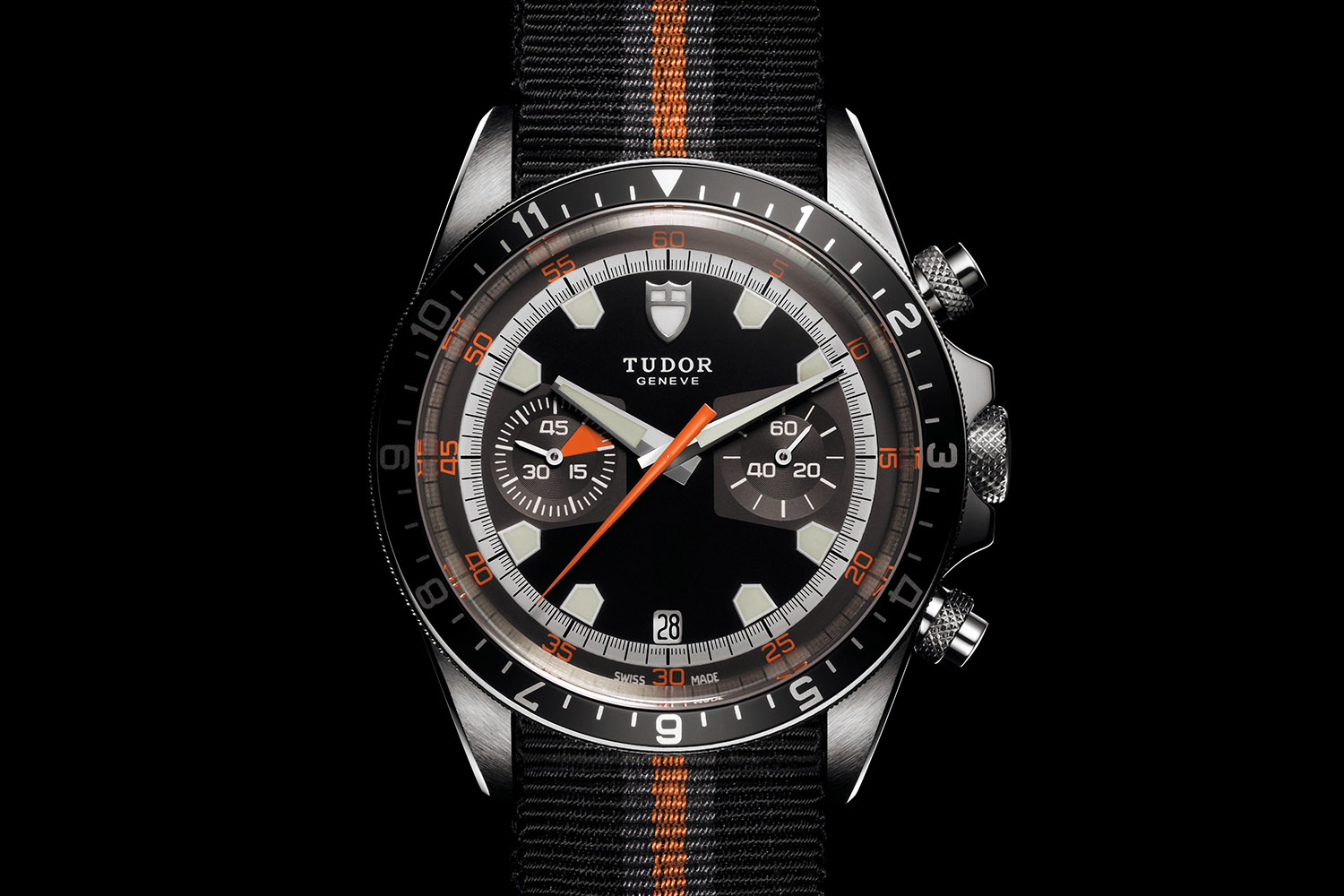

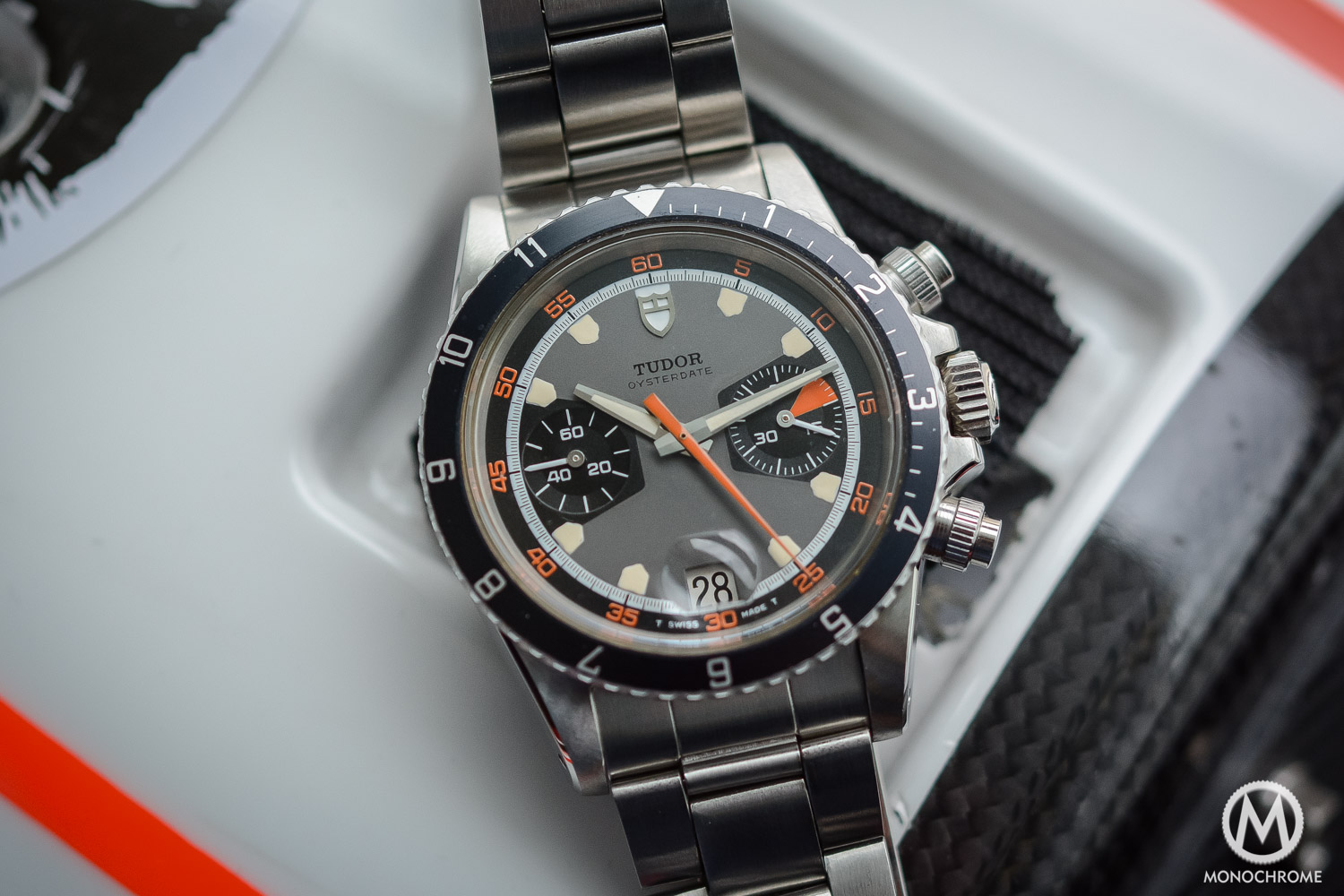
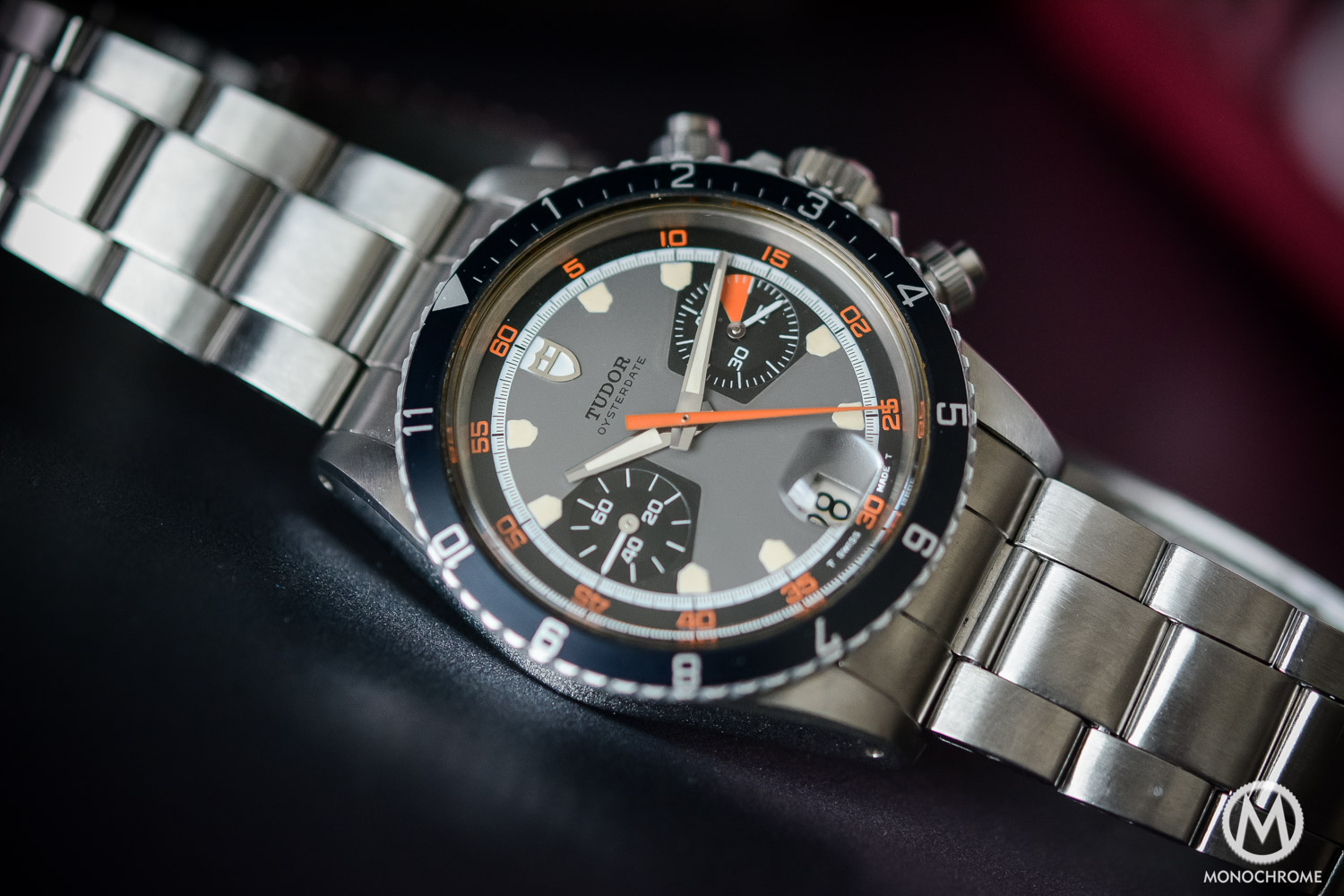

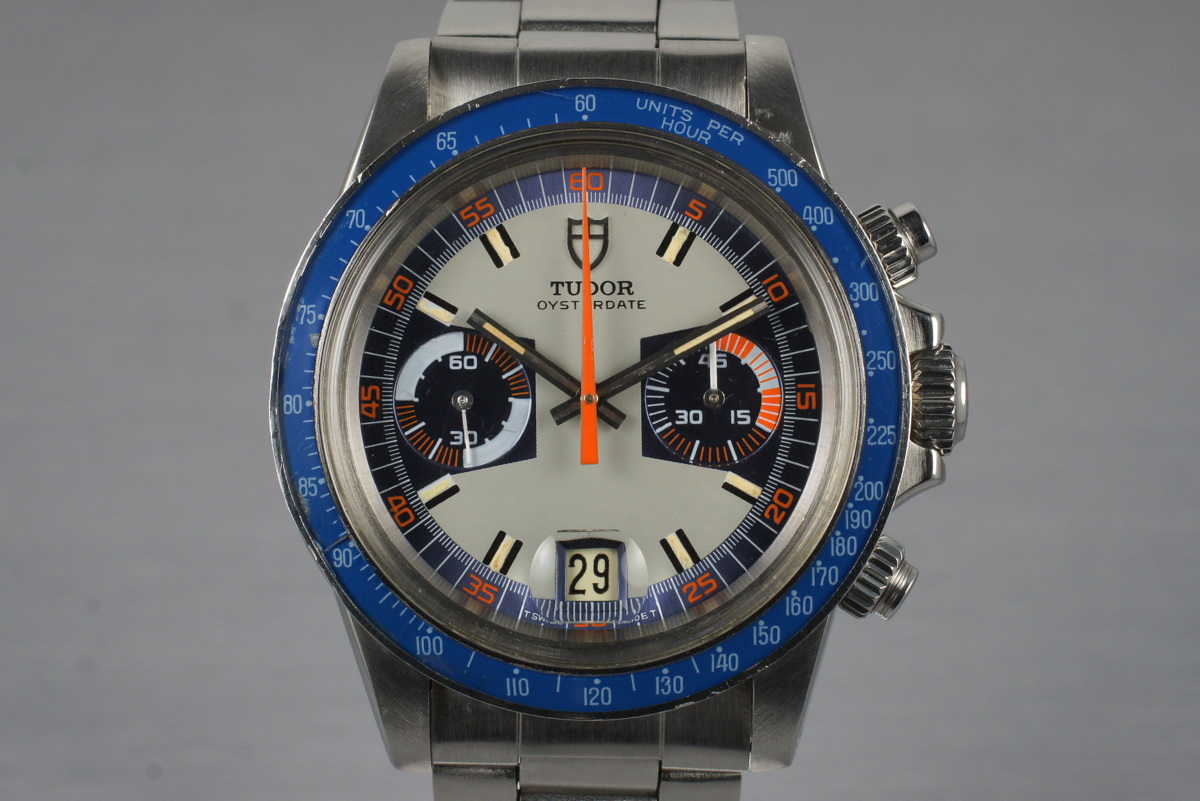
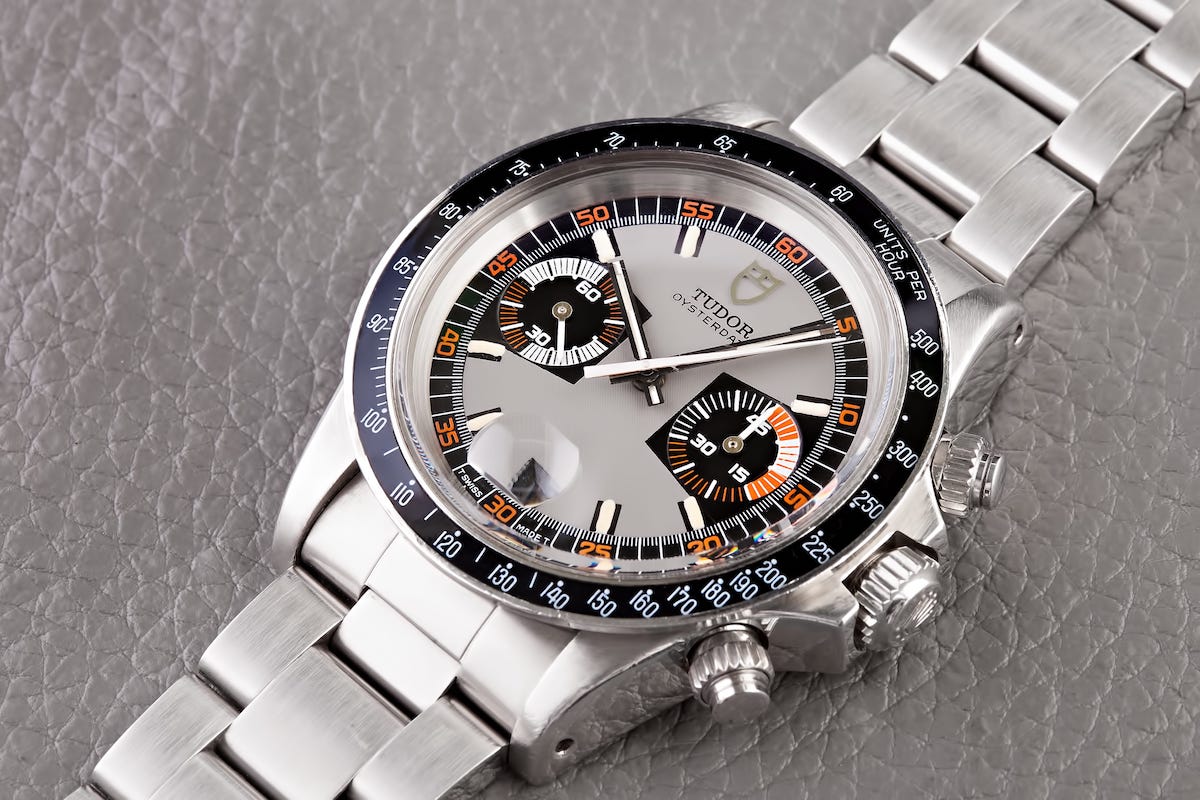
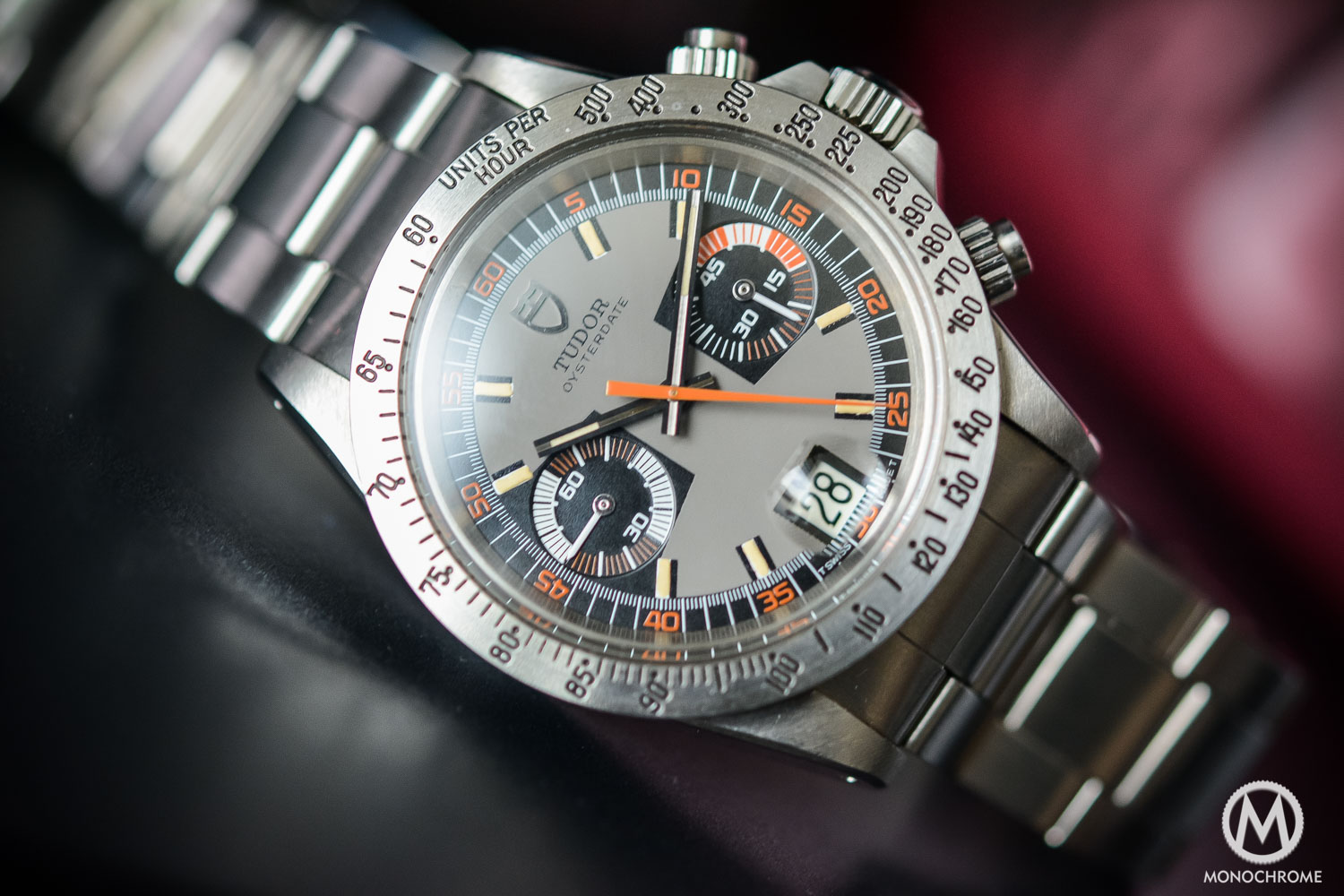
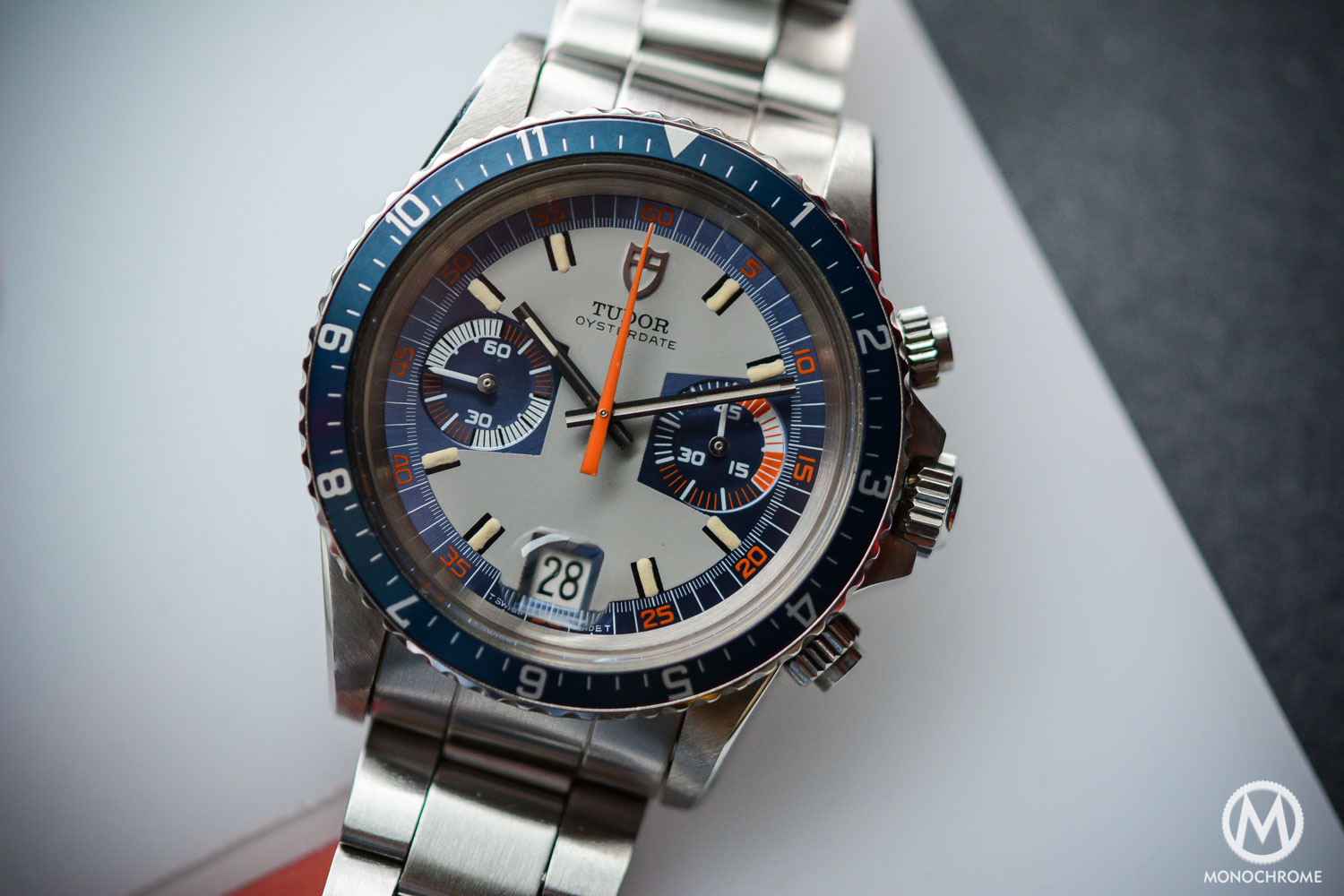
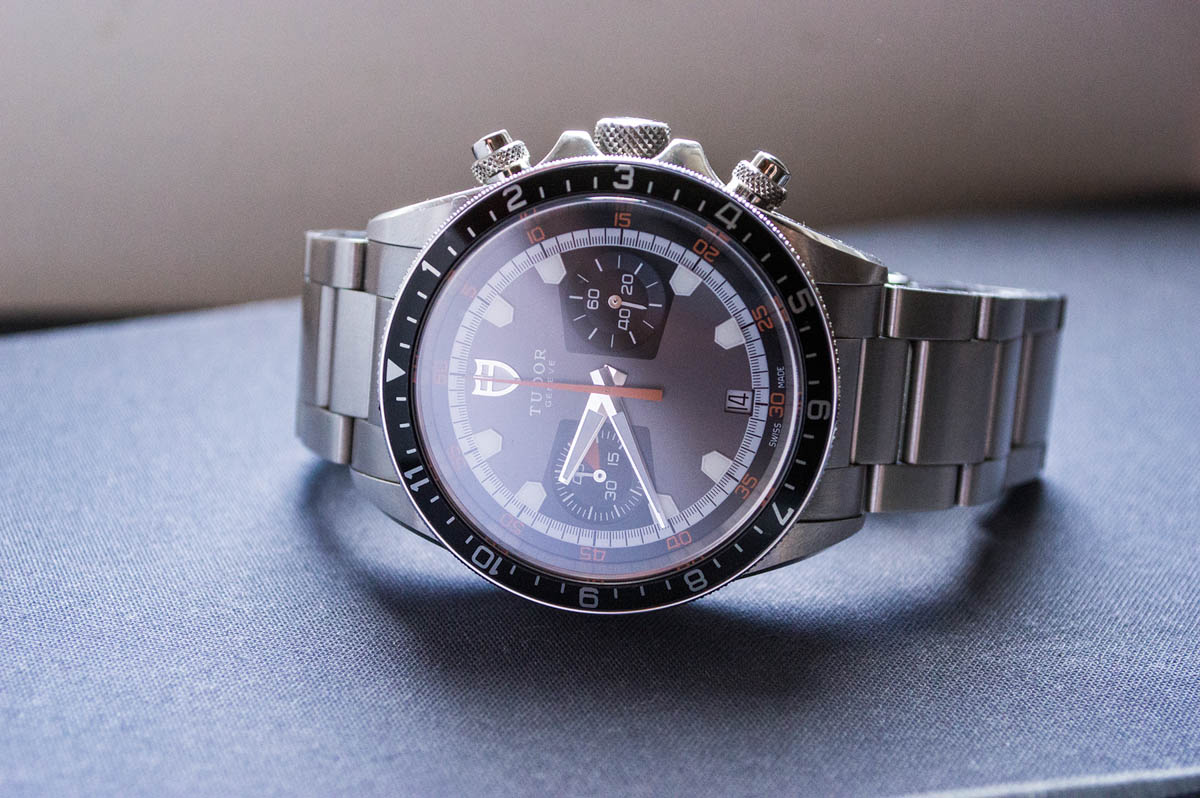
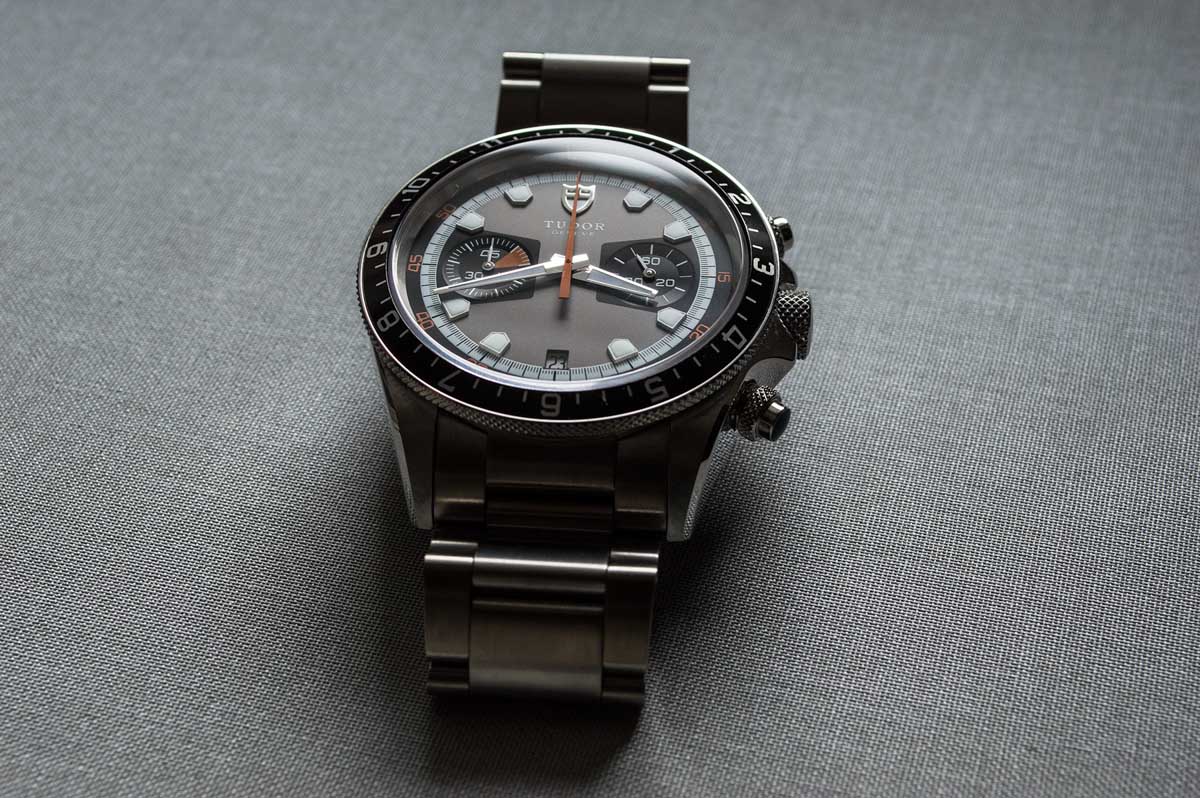
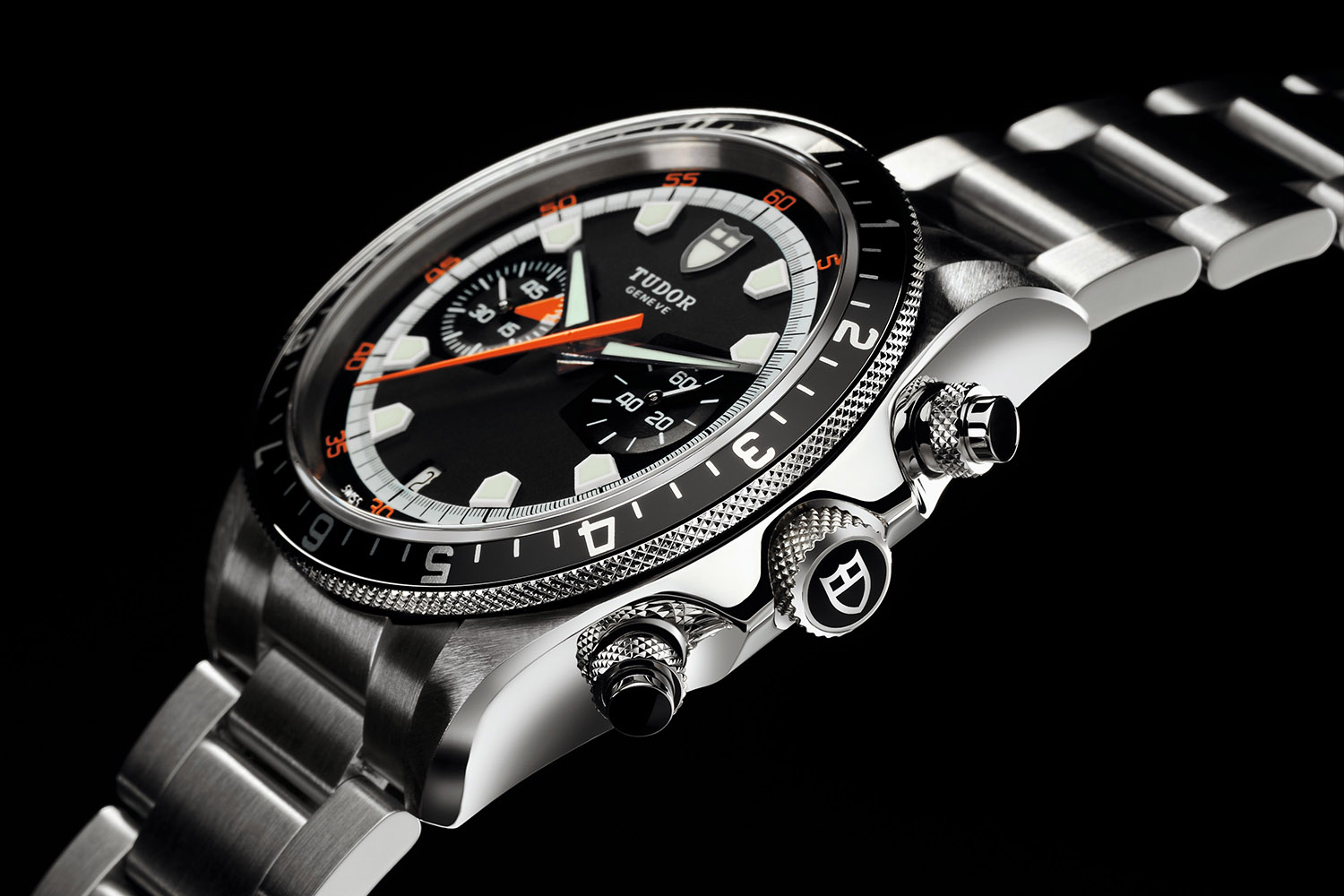

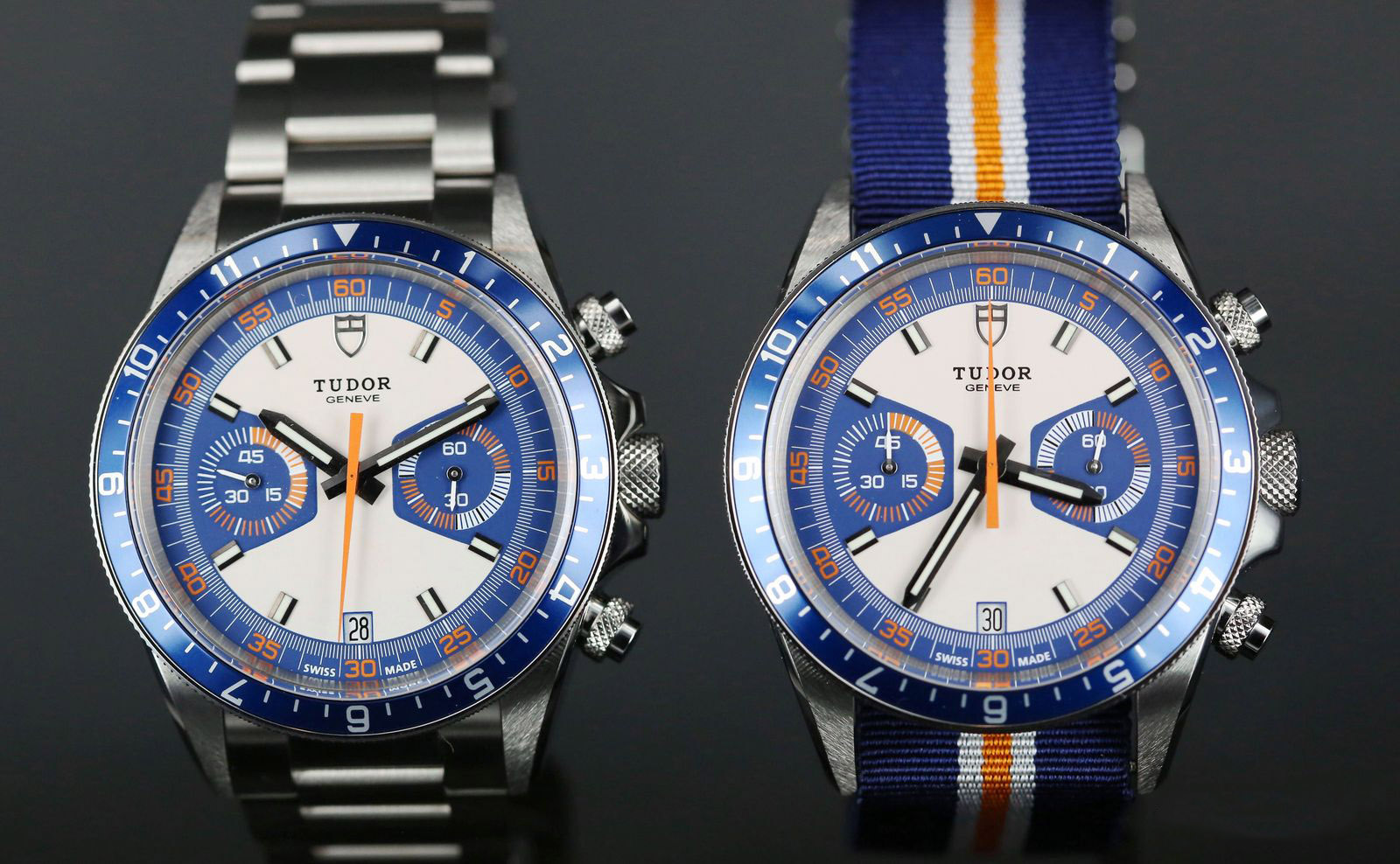



1 response
Beautiful watches without looking old fashioned. I have seen and/or own some of the heritage watches being reintroduced these days. Many great reissues can be had from Edox, Longines, Oris, and more.
Great history and article on these Tudors!